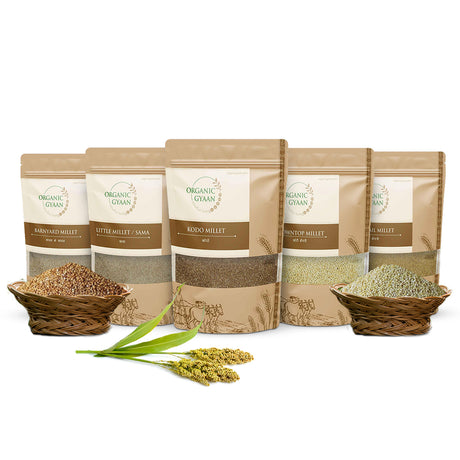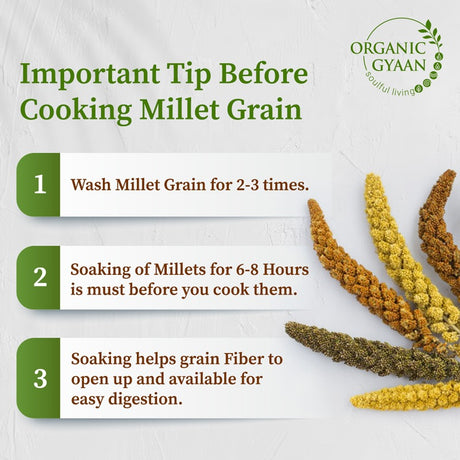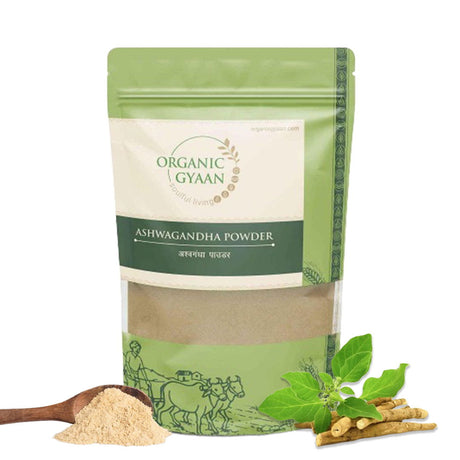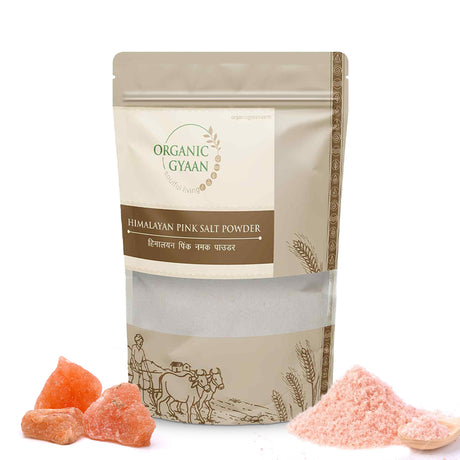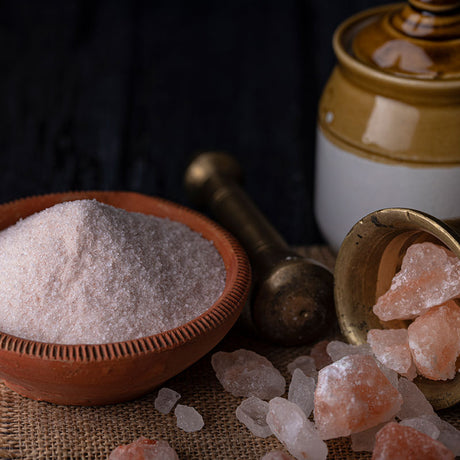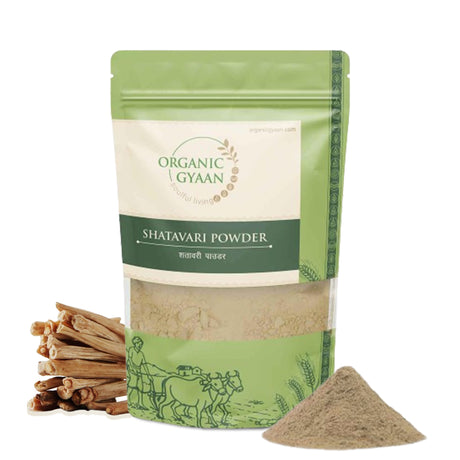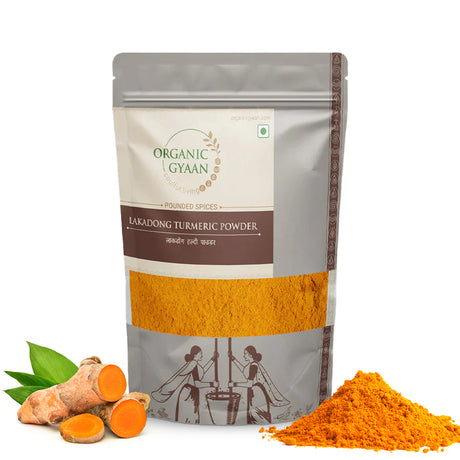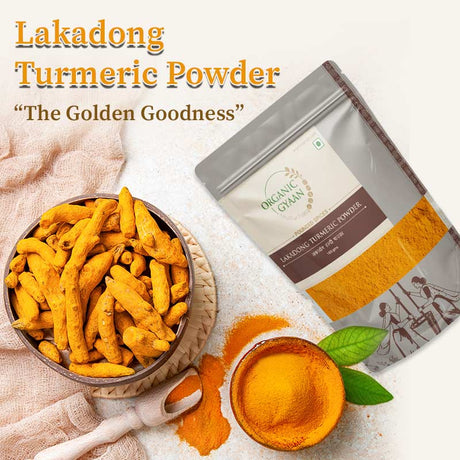Did you know that semolina, a staple in many Indian kitchens, is not only used to make delicious dishes like upma and halwa but also offers numerous health benefits? But what is semolina exactly? Semolina is a coarse flour traditionally made from durum wheat, which is high in protein and gluten. However, semolina can also be made from various types of millet, like ragi, bajra, and jowar, offering even more nutritional benefits.
In this blog, we will explore what semolina is, its nutritional value, the benefits of wheat and millet semolina, and how you can use them in your cooking. Whether you're already familiar with semolina or just discovering it, learn how these different types of semolina can be a healthy addition to your diet.
Types of Semolina
When we talk about semolina, most people think of wheat semolina, which is the most common type. However, semolina can be made from different grains, each offering unique flavors and health benefits. Here are some popular types of semolina:
1. Wheat Semolina:
This is the most widely used type of semolina, made from durum wheat. It is high in protein and gluten, making it ideal for making pasta, bread, and various Indian dishes like upma and halwa. Wheat semolina is known for its coarse texture and rich flavor, which makes it a versatile ingredient in many recipes.
2. Rice Semolina:
Made from rice, this type of semolina is often used in South Indian cuisine to prepare dishes like idli and dosa. It is naturally gluten-free, making it a good option for those with gluten intolerance or celiac disease. Rice semolina is smooth in texture and has a mild flavor that blends well with various ingredients.
3. Corn Semolina:
Also known as cornmeal, this type of semolina is made from ground corn. It is commonly used in baking and cooking to make cornbread, muffins, and tortillas. Corn semolina has a slightly sweet taste and a coarse texture, adding a unique flavor and crunch to dishes.
4. Millet Semolina:
While traditional semolina is made from durum wheat, there are also varieties made from different types of millets. Millet semolina is becoming increasingly popular due to its unique flavor and added health benefits. Millets like ragi, bajra, and jowar offer gluten-free options that are rich in fiber, vitamins, and minerals. Here are some common types of millet semolina:
- Ragi (Finger Millet) Semolina: Ragi semolina is rich in calcium and iron, making it excellent for bone health and preventing anemia. It also has a high fiber content, which aids in digestion and helps control blood sugar levels.
- Bajra (Pearl Millet) Semolina: Bajra semolina is packed with nutrients like protein, fiber, and magnesium. It is beneficial for heart health and can help manage diabetes due to its low glycemic index.
- Jowar (Sorghum) Semolina: Jowar semolina is gluten-free and rich in antioxidants, making it a good option for people with gluten intolerance. It is also high in fiber, which supports digestive health and aids in weight management.
- Foxtail Millet Semolina: Foxtail millet semolina is a good source of protein and dietary fiber. It helps in maintaining healthy blood sugar levels and supports overall health.
These types of millet semolina offer a range of health benefits and can be used in various recipes, just like traditional semolina. They are a great alternative for those looking to try something new while boosting their nutrient intake.
Semolina Nutrition Facts
To understand the semolina benefits, it’s helpful to know about its nutritional value. Here’s a quick overview of the nutritional value of semolina, showing just how nutrient-dense it is:
|
Nutrient |
Amount per 100 grams |
|
Calories |
360 |
|
Protein |
12.7 grams |
|
Carbohydrates |
72.8 grams |
|
Fiber |
3.9 grams |
|
Fat |
1.05 grams |
|
Calcium |
17 mg |
|
Iron |
1.23 mg |
|
Magnesium |
47 mg |
|
Potassium |
186 mg |
Semolina is a good source of protein and carbohydrates, making it a great energy-boosting food. It is also low in fat and contains essential minerals like iron and magnesium, which are important for maintaining good health.
Benefits of Semolina
Now that we have a basic understanding of semolina nutrition and the different types of millet semolina, let’s explore the various semolina benefits and why you should consider adding it to your diet.
1. Rich in Protein
One of the most significant benefits of semolina is its high protein content. Semolina flour contains about 12.7 grams of protein per 100 grams, making it an excellent source of plant-based protein. Protein is essential for building and repairing tissues, producing enzymes and hormones, and supporting overall growth and development.
Including semolina in your diet can help meet your daily protein needs, especially if you are vegetarian or vegan. It can be a valuable addition to your meals, providing a good balance of essential amino acids required for maintaining muscle mass and overall health.
2. Good Source of Energy
Wheat semolina is a great source of complex carbohydrates, which provide a steady source of energy throughout the day. Unlike simple carbohydrates that can cause a quick spike and drop in blood sugar levels, complex carbohydrates in semolina are digested slowly, providing sustained energy. Eating semolina can help keep you energized and active, making it an ideal food choice for breakfast or a mid-day meal.
3. Supports Digestive Health
Another important benefit of semolina is its fiber content. Semolina contains about 3.9 grams of fiber per 100 grams, which is essential for maintaining a healthy digestive system. Fiber helps regulate bowel movements, prevent constipation, and promote the growth of beneficial bacteria in the gut.Including semolina in your diet can help support digestive health and improve overall gut function.
4. Helps Control Blood Sugar Levels
Semolina can also help control blood sugar levels, making it a good choice for people with diabetes. The low glycemic index (GI) of semolina means it does not cause a rapid spike in blood sugar levels.
Additionally, the fiber in semolina slows down the absorption of sugar into the bloodstream, helping to prevent sudden spikes in blood sugar.Eating semolina as part of a balanced diet can help manage blood sugar levels and provide a steady source of energy.
5. Rich in Iron
One of the lesser-known semolina benefits is its iron content. Iron is essential for the production of red blood cells and for transporting oxygen throughout the body. A deficiency in iron can lead to anemia, which causes fatigue, weakness, and other health issues.
Wheat semolina provides a good amount of iron, making it a great addition to the diet, especially for those who may have a higher risk of iron deficiency, such as vegetarians, vegans, or women of childbearing age.
6. Rich in Magnesium
Semolina benefits also include its rich mineral content. Semolina is a good source of magnesium, which plays a vital role in muscle function, nerve function, and bone health. Magnesium is essential for hundreds of biochemical reactions in the body, including protein synthesis, muscle and nerve function, and blood sugar control.Including semolina in your diet can help ensure you get these important minerals and support your overall health.
7. Low in Fat
One of the benefits of semolina is that it is low in fat, making it a healthy choice for those looking to manage their weight or reduce fat intake. Semolina contains only about 1.05 grams of fat per 100 grams, which makes it a great option for those on a low-fat diet. Including semolina in your meals can help you enjoy delicious dishes without worrying about excess fat intake.
8. Versatile and Easy to Use
Semolina uses are numerous, making it a versatile ingredient in the kitchen. It can be used to make a variety of dishes, from savory breakfasts like upma to sweet desserts like halwa.
Semolina flour is also used in baking, making it an excellent choice for bread, cakes, and cookies.Using semolina in your cooking can help you create a wide range of delicious and nutritious dishes that the whole family will enjoy.
How to Use Semolina in Your Diet
Now that you know the benefits of semolina, here are some simple ways to include it in your daily diet:
- Breakfast: Start your day with a bowl of semolina porridge or upma. These dishes are not only delicious but also provide a good amount of energy to keep you going throughout the morning.
- Baking: Use semolina flour in baking to make bread, cakes, and cookies. It adds a unique texture and flavor to baked goods.
- Desserts: Make traditional Indian desserts like halwa or kesari using semolina. These sweets are easy to make and are a great way to enjoy the benefits of semolina.
- Pasta and Noodles: Use wheat semolina to make homemade pasta or noodles. It provides a chewy texture and rich flavor that store-bought pasta can’t match.
- Coating: Use semolina as a coating for fried foods like cutlets and fritters. It gives a crispy texture and adds a delicious crunch to your dishes.
Conclusion
The benefits of semolina are numerous, making it a valuable addition to any diet. From providing protein and fiber to supporting digestive health and controlling blood sugar levels, semolina offers a wide range of health benefits that can improve your overall well-being. Whether you enjoy it in traditional Indian dishes or use it in baking, semolina is a versatile and nutritious ingredient that can help you achieve your health goals.
Ready to enjoy the health benefits of semolina? Start adding this versatile and nutritious ingredient to your daily diet today and see how it can improve your health. Whether you’re using semolina for its protein content or to support digestive health, there’s a place for this ingredient in every kitchen.


